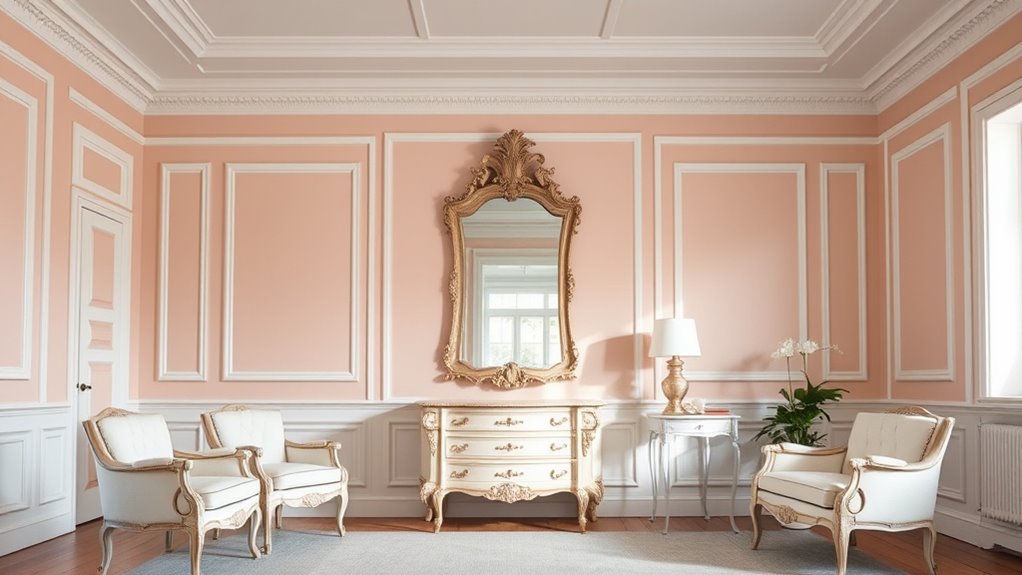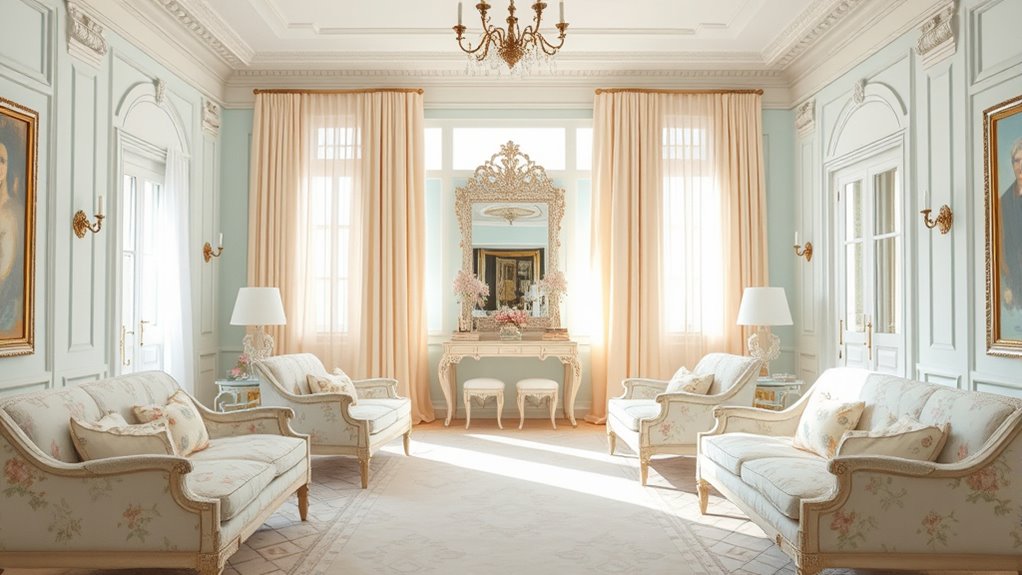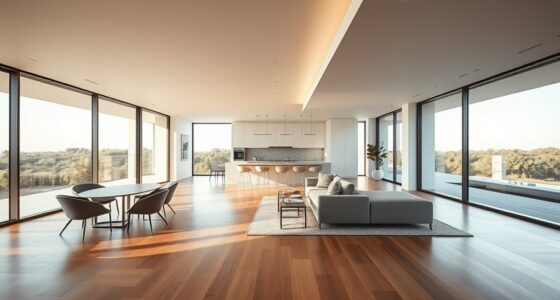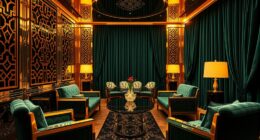Gustavian style features soft pastel colors like pale blues, blush pinks, and gentle yellows that create a calm, inviting space. Its design relies on symmetry and balanced proportions, giving your interiors a refined and harmonious feel. Clean lines, smooth surfaces, and understated details emphasize understated luxury without excess ornamentation. If you want to understand how these calming hues and balanced forms combine to evoke elegance and serenity, there’s more to discover about this timeless Scandinavian aesthetic.
Key Takeaways
- Gustavian style features soft pastel shades like pale blues, pinks, and yellows to create a serene, light-filled atmosphere.
- It emphasizes symmetry and proportion in furniture and interior layouts for balanced, harmonious spaces.
- Light-colored woods and subtle details reflect elegant simplicity rooted in 18th-century Scandinavian design.
- The style combines refined craftsmanship with understated decoration, promoting calm and sophisticated aesthetics.
- Its use of pastels and symmetry evokes a noble yet approachable charm characteristic of Gustavian elegance.

Gustavian Style, named after King Gustav III of Sweden, embodies the elegant simplicity and refined grace of late 18th-century Scandinavian design. As you explore this style, you’ll notice how its furniture design emphasizes clean lines, gentle curves, and understated yet sophisticated details. The furniture is often crafted from light-colored woods like oak or painted in soft shades, reflecting a sense of calm and restraint. You’ll appreciate how each piece is both functional and aesthetically pleasing, with an emphasis on symmetry and proportion that creates a harmonious environment. The furniture design avoids ornate decoration, instead favoring subtle carvings and smooth surfaces that highlight craftsmanship without overwhelming the eye. Additionally, the use of symmetry and proportion helps establish visual balance and order within a space, enhancing the overall sense of harmony. When it comes to the color palette, Gustavian Style leans heavily on pastels and muted tones that evoke a sense of serenity. You’ll find shades like pale blues, soft grays, gentle yellows, and blush pinks, all chosen to enhance the light, airy atmosphere characteristic of Scandinavian interiors. These colors are often paired with crisp whites, which serve as a clean backdrop that amplifies the subtle hues and highlights the furniture’s elegant lines. The palette is deliberately restrained, allowing the form and craftsmanship of each piece to shine through without distraction. This use of delicate colors also contributes to a sense of openness and brightness, making even smaller rooms feel more expansive. The color palette in Gustavian interiors isn’t just about aesthetics; it’s about creating a mood of tranquility and understated luxury. You’ll notice how the soft pastel hues are used strategically to add warmth and personality while maintaining a sense of balance and harmony. The overall effect is one of refined simplicity—luxurious without being ostentatious. The furniture design complements this approach by favoring symmetry and proportion, which together foster a sense of order and calm. Whether you’re choosing a painted console table, a set of chairs, or a decorative mirror, you’ll see how these elements work in concert to evoke the timeless elegance of the Gustavian aesthetic. In essence, Gustavian Style’s furniture design and color palette come together to create spaces that feel both welcoming and sophisticated. It’s a style that celebrates the beauty of simplicity, where every piece and hue is carefully selected to enhance the overall harmony. As you incorporate these elements into your home, you’ll find that this style offers a perfect balance of form and function, elegance and comfort, all rooted in the noble yet approachable charm of late 18th-century Scandinavian design.
Frequently Asked Questions
How Did Gustavian Style Influence Modern Swedish Interior Design?
You can see Gustavian style’s influence in modern Swedish interior design through its neoclassical revival, emphasizing symmetry, soft pastel palettes, and elegant simplicity. Contemporary reinterpretations blend these timeless elements with modern minimalism, creating spaces that feel both historic and fresh. By incorporating Gustavian-inspired furniture and color schemes, you bring a touch of Swedish elegance into your home, celebrating a tradition that continues to inspire current design trends.
What Are Common Color Palettes Used in Gustavian Interiors?
You’ll notice that Gustavian interiors often feature a palette of pastel shades and soft neutrals, creating a calm, elegant atmosphere. It’s believed that these colors were inspired by the Swedish landscape and historical influences, making spaces feel light and airy. You might see pale blues, gentle pinks, muted yellows, and soft grays, all combined to evoke a sense of understated sophistication and timeless charm.
Can Gustavian Style Be Incorporated Into Small Spaces?
Yes, you can incorporate Gustavian style into small spaces by choosing compact furniture that maintains the elegant, airy feel. Use multifunctional layouts to maximize space, such as a sofa bed or a dining table that doubles as a workspace. Stick to light pastel colors and symmetry to create a sense of balance and openness. This approach helps you achieve the classic Gustavian charm without overwhelming your compact area.
How to Distinguish Authentic Gustavian Furniture From Reproductions?
To distinguish authentic Gustavian furniture from reproductions, look closely at the wood grain; genuine pieces often show natural variations and aged patina. Check the carving details—authentic items feature fine, precise craftsmanship with delicate accents. Reproductions may have less refined carvings and a more uniform finish. Trust your senses: authentic furniture exhibits a sense of history and subtle imperfections, while reproductions tend to look newer and more manufactured.
What Are Typical Decorative Motifs in Gustavian Decor?
Imagine walking into a room where ornate floral patterns adorn the furniture and walls, instantly evoking Gustavian decor. You’ll notice ornamental motifs like carved rosettes, laurel wreaths, and acanthus leaves, which emphasize elegance and symmetry. These decorative motifs often feature delicate floral patterns that reflect neoclassical influences, creating a balanced, refined atmosphere. Keep an eye out for these motifs to identify authentic Gustavian style with its graceful, understated charm.
Conclusion
By embracing Gustavian style, you bring a touch of Swedish elegance and serenity into your space, with pastels and symmetry guiding your design choices. Remember, true beauty lies in balance—like a well-tuned playlist, it’s about harmony, not perfection. So, channel your inner Marie Antoinette, and don’t be afraid to mix a little modern flair with classic charm. After all, in the end, life’s about creating your own timeless masterpiece.








